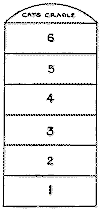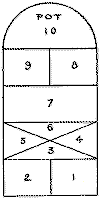By Dan Beard

Fig. 291.
An English Court with Eleven Subdivisions and a Plum Pudding.
One would suppose that where thousands of children are every year killed by wild beasts and poisonous snakes, and where boys and girls are compelled to marry like grown-up people, the boys would be so busy fighting tigers, killing snakes, and attending weddings, that they would find no time in which to play. But in India, where all these things take place, such is not the case. The games the young East Indians play are perhaps as numerous as those in vogue in America, and many of them are the same. Often the little natives may be seen hopping around on one brown, bare foot regardless of snakes -intent upon the game of hop-scotch [or hopscotch].
From far Hindoostan, all the way across the map of Europe and Great Britain, in every town, chalked on the sidewalk or scratched on the ground, may be found the boys' hop-scotch courts. Not content with crossing the English Channel, this popular game has traversed the wide Atlantic and spread all over the United States, and it is only a matter of time when, by the way of California and the Pacific Islands, it will reach Japan and China. The whole world will then be encircled with a chain of hop-scotch courts, and who will dare to say that it is not a popular game?
The Hop-Scotch Court

Fig. 292.
The Six Divisioned English Court with Cradle.
is drawn with chalk or a soft brick on the stone flags of a sidewalk, or is scratched with a stick on a piece of hard, level ground. It is about twenty feet long and five or six feet wide. Figs. 291, 292, and 293 show some English courts, and Fig. 294 shows an American court. Fig. 295 is a modification of the American court made so that the flags of the pavement make the courts and only require a few cross lines and numbering.

Fig. 293
The Simplest English Court with Cat's Cradle.
A taw line is drawn a short distance from the court. In England the last division or sub-court at the top of the main court is called "cat's cradle " or " plum pudding; " in Italy, the "bell;" in New York, the "pot," and in Austria, the temple."

Fig. 294.
A Typical American Court with Ten Subdivisions.
The little Italian boys give a religious significance to the game by calling the last three divisions Infernal Regions, Purgatory, and Paradise; and it must be very encouraging to them, because if they play long enough they are sure to reach Paradise.
The Potsherd.
Originally a broken piece of crockery, a shell, or a small flat stone was used for the potsherd to play with, but now a bit of old tin folded and refolded, and hammered flat with a hammer, brick, or any other heavy object, is the favorite potsherd, though a piece of brick or a stone is often 'used.
The Game.
After deciding who shall be first, second, etc., the player stands at taw and tosses the potsherd into division number one (Fig. 294). Hopping on one foot over the line into number one and still keeping one foot raised, he makes a hop-kick with the other and sends the potsherd out of the court. Whenever he fails to do so the next player takes a turn.
After kicking out of number one the player returns to taw and tosses the tin into number two. Then he "jumps a straddle," that is, he jumps so as to straddle the division line between number one and number two, with one foot in each of these divisions of the court, and without lifting up either foot he makes a sliding kick, sending the tin into number one. Then, hopping into that division he makes another hop-kick, sending the potsherd out.
In this manner all the divisions are played, with a straddle jump over the dividing lines at four and five and eight and nine, the player always going through the lower divisions as he came, with a hop or a straddle. At ten, after hopping three times around in the "pot," he strikes the potsherd with his toe and sends it through all the divisions toward the taw line, with hops and straddles the way he came.
Sometimes at seven and ten he is required, while still standing on one foot, to pick up the potsherd, place it on the top of his ground foot, and then with a hop-kick throw it toward taw, clear of the court. Or with an upward jerk he may send the potsherd up in the air, catch it with his hands, replace it in the court, and kick it out without touching his foot to the ground. After doing the "pot," " plum pudding," "cat's cradle," or "paradise," he goes backward through all the divisions to number one, and the game is finished.
In Fig. 293, with four divisions and a cradle, there are no straddles. In Fig. 292, with six divisions and a cradle, there are no straddles, but in Fig. 291, with eleven divisions and a plum pudding, there is a straddle at two and three, eight and six, ten and eleven, and a "pick up and kick," as described above, at four and nine and the plum pudding.

Fig. 295.
An American Court Adapted to Stones of Sidewalk.
In the American game (Fig. 295) there is a straddle at one and two, a single at three, a straddle at four and five, a single at six, a straddle at seven and eight, and a single at nine. When the potsherd is pitched into ten, the player hops into one, straddles into one and two, hops into three, hops into four, straddles into four and five, hops into six, straddles into seven and eight, hops into nine, hops into the space surrounding the small pot ten, and then, without putting his foot to the ground, hops three times around the center pot and into it.
If he is successful so far, he kicks the potsherd toward taw out of the court, and returns the way he came. If there is any one who looks with contempt upon this game, thinking it a simple baby play, let him attempt this last feat and ever afterward he will consider hop-scotch a sport in which it requires no small amount of skill to succeed.
Grounds Out:
When the player touches his foot or hand to the ground it is called " grounds," and he is out. When a player pitches the potsherd in the wrong division or on a line, he is out. When he kicks it into the wrong division or on a line, he is out; and in each case the next in turn plays from taw, and the other players, when their turns come around again, begin at the division they failed in.
Hop-Scotch on Stilts:
If any one of my readers wishes to try a game that will test his athletic skill, let him try hop-scotch on the simplest English court (Fig. 293) with a pair of " gadabouts," such as are described in Up in the Air on Stilts, strapped to his legs, and he will find it no simple game.